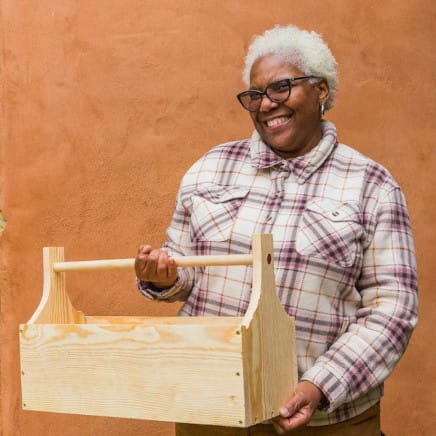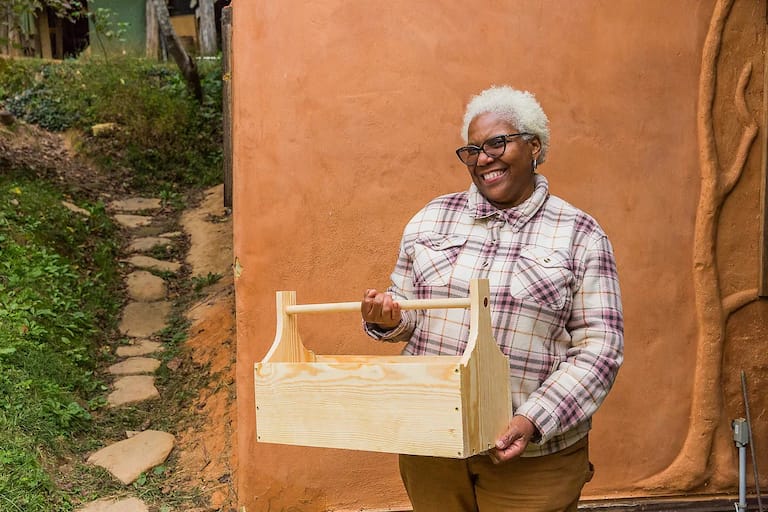On This Page
We welcome you to read through this page for a whole-picture perspective on our Women’s Basic Carpentry Classes. If you’re looking for specific information, you can use the following links to skip around:
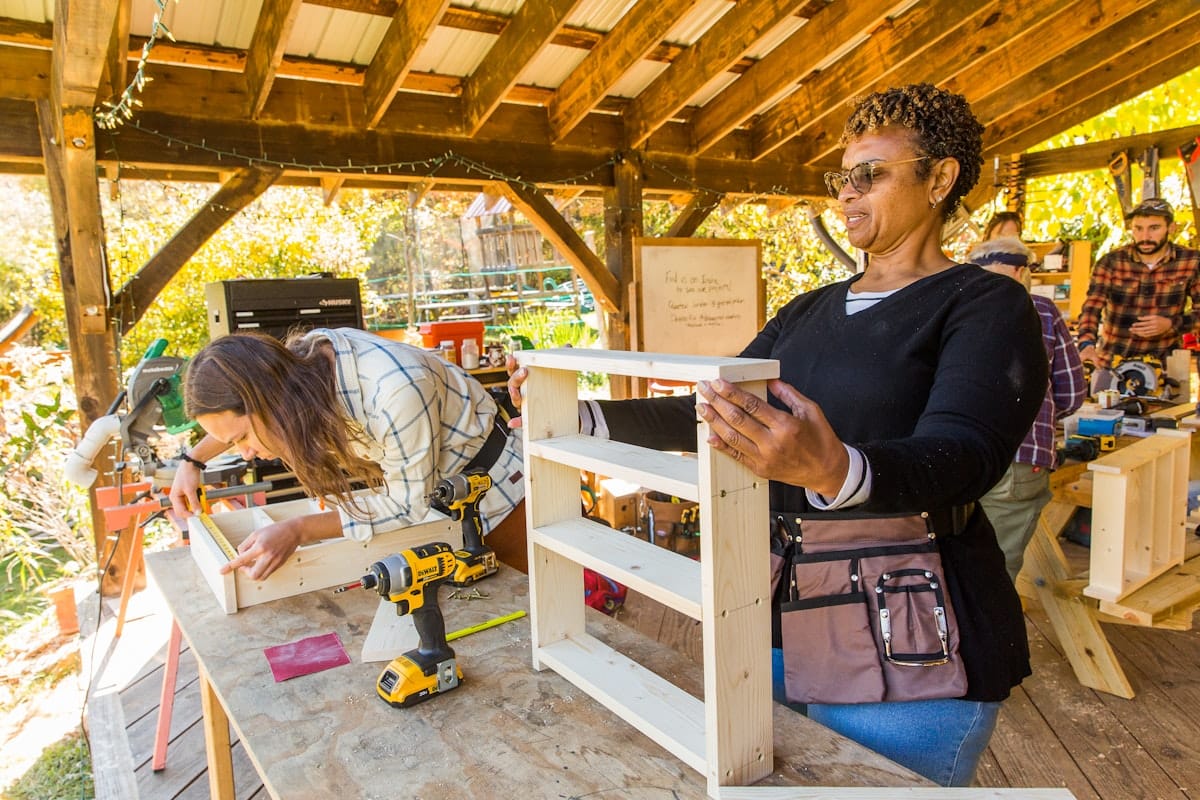
Why Carpentry for Women?
Let’s face it, female-bodied folks are less likely to grow up using tools and building things than our male counterparts. Women also don’t see folks who look like us doing carpentry for themselves. The story that working with wood is only for men is outdated and in need of rewriting!
Our basic carpentry classes for women are intended to respond to that need. They get women and non-binary folks up-to-speed on basic carpentry skills, including working with wood, planning and designing simple projects, and using hand and power tools safely and effectively.
There is a special magic that happens when we create a space to learn carpentry without any macho energy. One of our teachers said it best, “There is a total lack of competition, and this makes for a place where learning can happen in a very different way.”
Our women’s carpentry classes are open to all women (including trans) and non-binary folks.
If carpentry for women isn’t for you, but you want to learn the basics, please check out our Adult Beginner Woodworking Class.
Focus is placed on creating a safe, comfortable, relaxed, and fun learning environment in which students with beginning to intermediate skill levels can thrive. Our goal in these basic women’s carpentry classes is to help each student learn, rather than to progress projects at a fast pace.
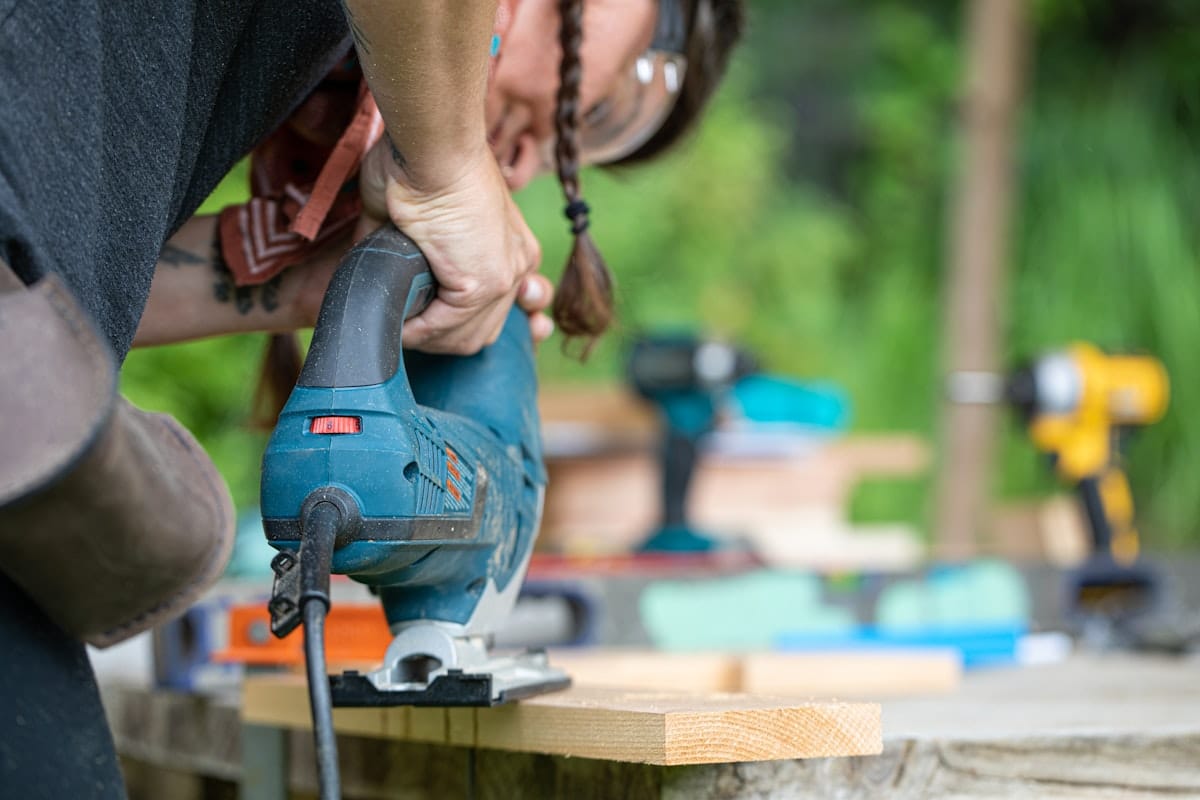
What Our Women’s Carpentry Class Students Say
scroll right to read more

Leslie
Virginia
College Worker
“I came here with absolutely no experience—I had never touched a power tool—and yet this was the most affirming and supportive environment I’ve ever experienced. Thank you, Wild Abundance. I will always remember this.”

Anne
Staten Island, NY
Retired Nurse Practitioner
“This class had a fabulous atmosphere and was a supportive learning experience. Turns out I’ve been using tools wrong for many decades… I was so thankful to have someone look at what I was doing and give me expert instruction. I learned an enormous amount and will be forever grateful for this opportunity. “
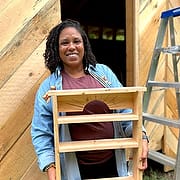
Deanna
Virginia
Massage Therapist and Mother
“I’m a stay-at-home-mom and massage therapist, so using my hands is something I’m really proud of. To be able to use the skills I picked up at Wild Abundance is something I’ll remember forever. If you’re thinking about it, go for it. It’s wonderful time. Life changing, in fact.”

Sally
Goose Creek, SC
Retired
“My sister and I took the basic carpentry class together—like some of the other students, we’re in our 70’s! We were welcomed into a community of resilient, independent, and caring women. We got to know ladies from different states and countries. We worked hard and learned skills that we took home to perfect. It was one of the most satisfying experiences! I will no longer fear power tools… although I’ll always respect them. I wish I’d taken this class earlier in my life!”

Janie
Nashville, TN
Clinical Mental Health Therapist
“The Women’s Basic Carpentry Class was a phenomenal experience. Never have I been in such a welcoming and affirming space for people of all experience levels—most of us absolute beginners. I learned an incredible amount of skills in only four days, and most importantly, I came away confident to engage immediately in building projects using power tools on my own.”
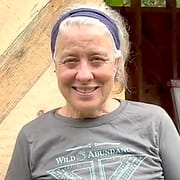
Julia
Colorado
Marketing Director
“The thing that I’m most thankful about with my experience at Wild Abundance is that it has opened up a whole new world to me through learning a new language, a language of tools, of wood, of carpentry, and of building. Equipped with this new language, I can learn how to build, I can read plans, I can go to the hardware store.”
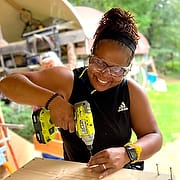
Charis
Virginia
Insurance IT Systems Integrations
“I’m usually sitting at a desk and it was amazing to work with my hands. I have gained the confidence I need to actually do the projects I want to do.”

Jeanne
Georgia
Project Manager
“The thing I enjoyed most about this class was getting to learn from people who are highly skilled… Now I feel a lot of confidence that I can go home and build another project, solve household problems, and really tackle anything!”
Ready to Join?
We’ll let you know when classes open for registration, and send you our fun and informative newsletters.
Our women’s carpentry classes are truly about the foundations of carpentry.
Our students learn how to use tools and get comfortable with them by working on both large and small projects.
No prior experience is required for our women’s carpentry classes. All ages are welcome; students from 16-76 have joined us and loved the class!
That said, if you have basic carpentry experience but don’t yet have mastery of safe and ergonomic use of the table saw, chop saw, circular saw, or hand tools, our basic carpentry classes are also for you.
If you’re interested in bigger projects, especially structural building, we offer an Advanced Women’s Carpentry Course for graduates of the basic class. In the advanced class, students learn to build a small and simple shed.
Anyone who has completed our basic carpentry class for women will be well prepared for the advanced class. If you bundle your enrollment for the Women’s Basic Carpentry Class with the advanced class, you’ll receive a discount that is automatically applied at checkout!
Another building class option, if you want to dive in really deeply, is our Tiny House Workshop. This class is appropriate for graduates of either the basic women’s carpentry class and/or the women’s advanced class. If you’re planning to take a series, we recommend starting with basics, then moving on to either advanced carpentry or tiny house building. You can take all three and build your carpentry and design skills as you go! Note: It doesn’t make sense to take the basics class after the tiny house class.
Prepare to tame those mythical beasts (power tools) and make them part of your building repertoire.
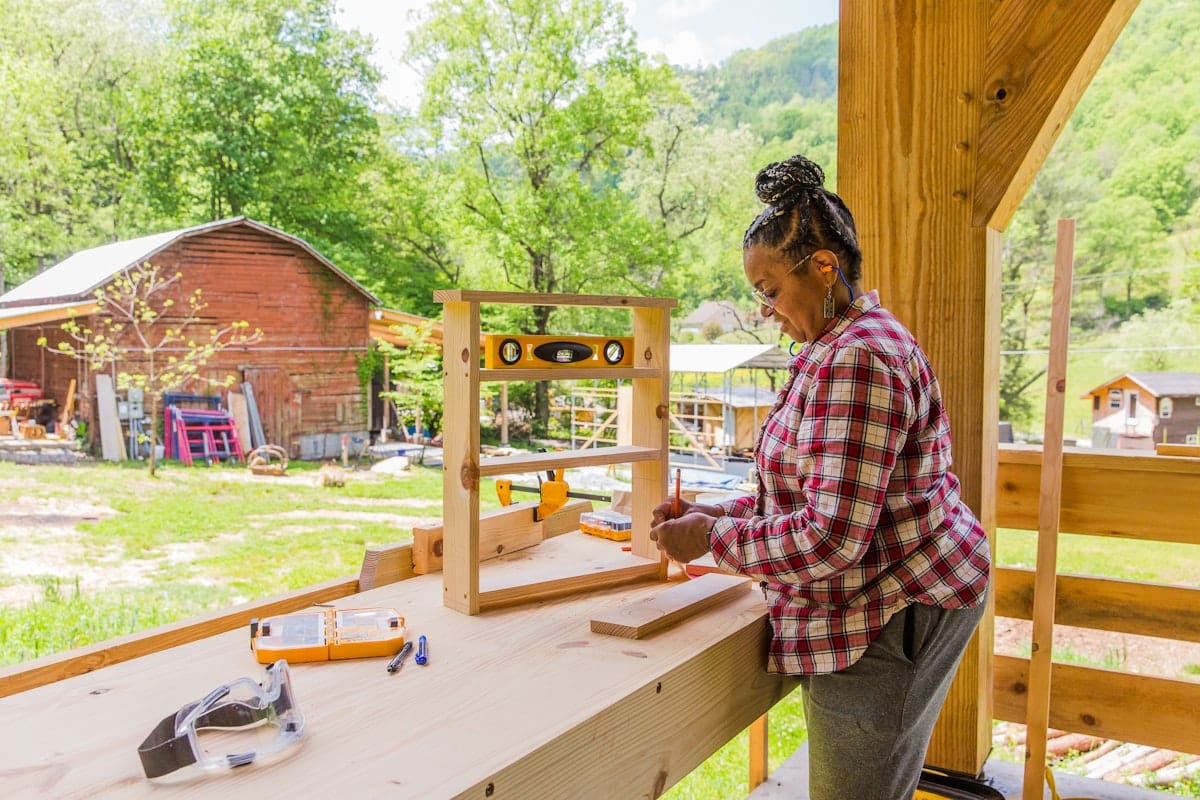
Is Carpentry for Women the same as Women’s Woodworking?
At the foundational level, carpentry and woodworking are quite similar—they both focus on basic tool use and the art of simple building. Our Women’s Basic Carpentry Class is relevant to both aspiring carpenters and woodworkers.
As students refine and advance their skills, however, the two crafts diverge a bit. Carpentry becomes focused on building structures and renovating or improving buildings while woodworking focuses on furniture-making, cabinetry, and art installations.
If you’re excited to hone your carpentry skills, you can enroll in our Women’s Advanced Carpentry Course and/or our Tiny House Building Workshop following the Women’s Basic Carpentry Class. Both of these classes are carpentry-focused, but you will learn skills that also apply to woodworking projects.
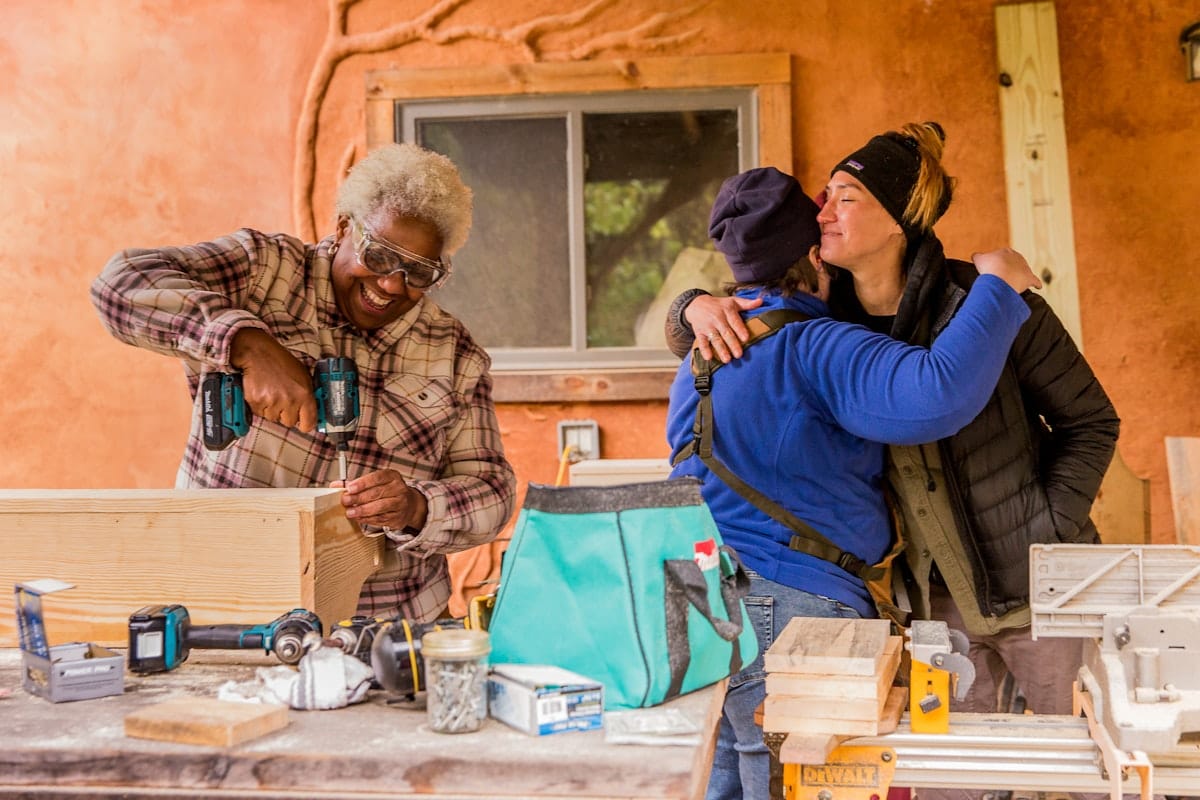
What to Expect in Our Basic Carpentry Classes for Women
During this four-day course, we’ll cover basic carpentry for women through lectures, demonstrations, and lots of hands-on practice.
Topics covered include:
- Safe and effective tool use (including hand and power tools)
- Choosing the right tools for different kinds of jobs
- Accurate measuring and cutting
- Hands-on tool practice in a group project setting
- Small project design and planning
- Lumber (wood) selection and purchasing
- Implementation of your own project
This wealth of information will be specifically tailored for female bodies and abilities. There will be ample time to dialogue with instructors and get clear about the subject matter. We firmly believe that there are no “dumb questions.”
Our theme on day one of the basic carpentry classes is women’s empowerment. To begin, we’ll have an orientation and overview of the class. Then we’ll move into the bulk of the day: tools and how to make accurate measurements! We’ll cover tool choices, their ergonomic use, and safety. Each tool will be introduced and demonstrated in detail, then you’ll get a chance to try it yourself (with plenty of guidance and support).
When we cover the more intimidating power tools—specifically the power saws—the class will break up into three groups, so each person can get personalized attention.
Carpentry Class Schedule and Timing
Four-Day Intensive Schedule
- Day 1: 9:00 am-5:30 pm
- Day 2: 9:00 am-5:30 pm
- Day 3: 9:00 am-5:30 pm
- Day 4: 9:00 am-4:30 pm
Each day includes a one‑hour lunch break.
Please note: Some classes will have slight changes in the schedule due to weather, the needs of the projects, and the desires of the group.
Want a weekday-only option?
Most of our Women’s Carpentry Classes are offered on a Thursday-Sunday schedule. By popular request, we’ll also be running a couple classes that meet Monday-Thursday in 2025. Be sure to check the class date and day options before choosing the session that works best for you.
Ready to Join?
We’ll let you know when classes open for registration, and send you our fun and informative newsletters.
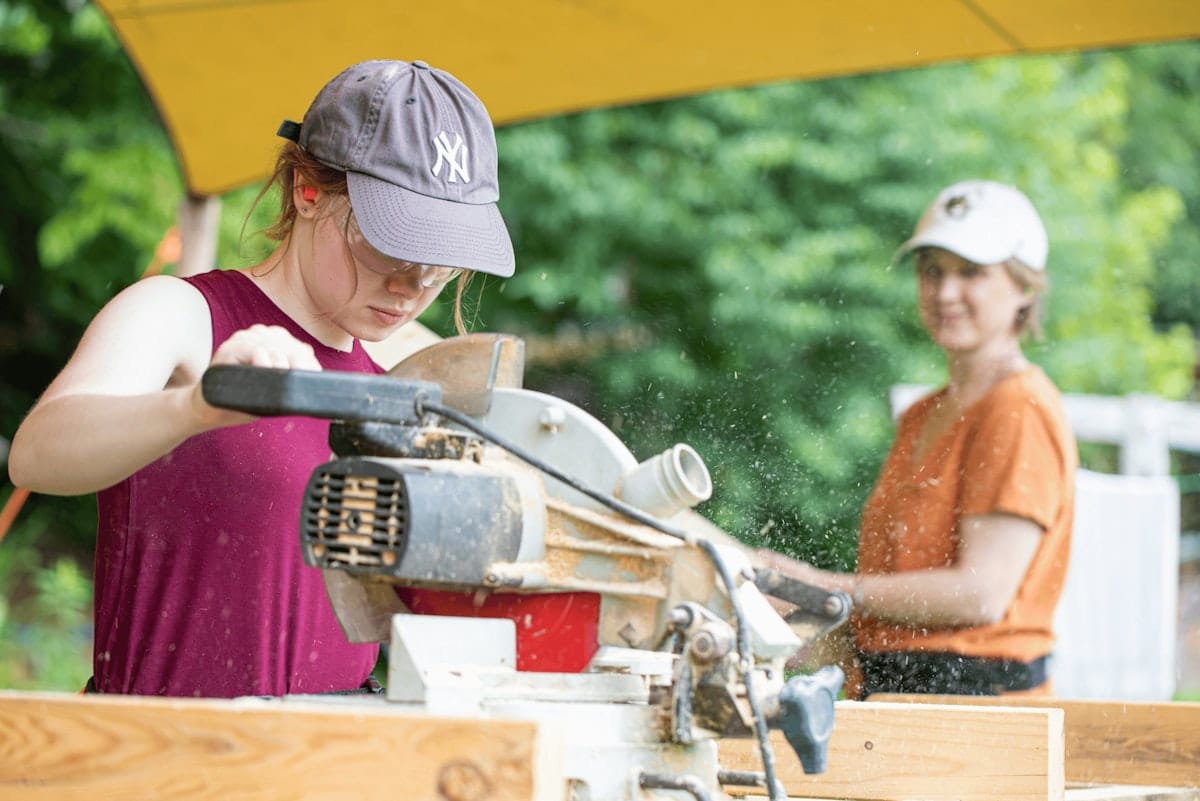
Day 1: Tools, Tools, Tools
And women’s empowerment!
Our theme on day one of the basic carpentry classes is women’s empowerment. To begin, we’ll have an orientation and overview of the class. Then we’ll move into the bulk of the day: tools and how to make accurate measurements! We’ll cover tool choices, their ergonomic use, and safety. Each tool will be introduced and demonstrated in detail, then you’ll get a chance to try it yourself (with plenty of guidance and support).
When we cover the more intimidating power tools—specifically the power saws—the class will break up into three groups, so each person can get personalized attention.
Whether you’re building a birdhouse, bathroom shelves, a bike shed, or a log cabin, having the right tools, and using them properly, makes all the difference.
Carpentry tools we’ll cover on Day 1 include:
- Carpenter’s pencil
- Utility knife
- Measuring tape
- Speed square
- Safety equipment
- Circular saw
- Table saw
- Miter saw (sometimes called a chop saw) and sliding miter saw
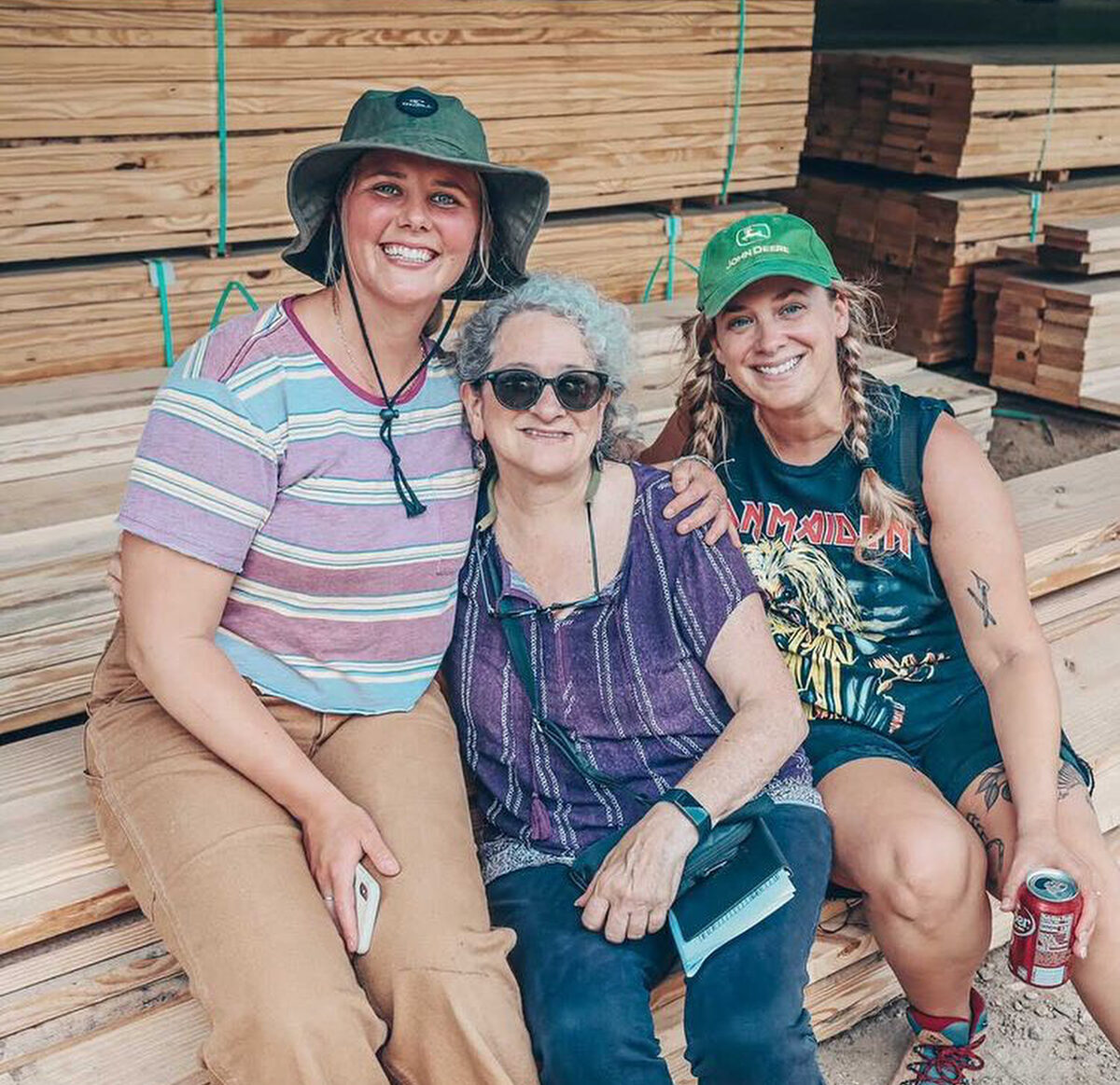
Day 2: More Tools, Project Design, and a Field Trip
Explore more tools, plan out your personal woodworking project, and learn to navigate a lumber yard.
On day two, we’ll get our hands on more tools, learning safe and proper use of:
- Drills for making holes in wood
- Impact drivers for driving screws
- Bits for the above-mentioned tools, each of which are quite different
Your Personal Project: The Capstone of Your Women’s Carpentry Class
On day two, you’ll also choose your own small personal project (to be built on day four) and will begin to design and plan for it. Of course, you’ll get plenty of support and guidance from the instructors.
In order to ensure optimal learning of various techniques and every student’s success within the timeframe of class, we limit personal project options. We offer a selection of simple objects to build, which we call “learning projects.” You can choose to build a tool caddy, a small shelf, or a birdhouse.
We’ll discuss what kinds of wood are appropriate for different projects and help you create your own materials list—essential tasks for a women’s woodworking class! After lunch, we’ll head to the lumber yard to pick out materials for everyone’s personal projects. While we’re there, we’ll explore lumber selection. Equipped with this knowledge, everyone will buy what they need for their personal projects, which we’ll tackle on day four.
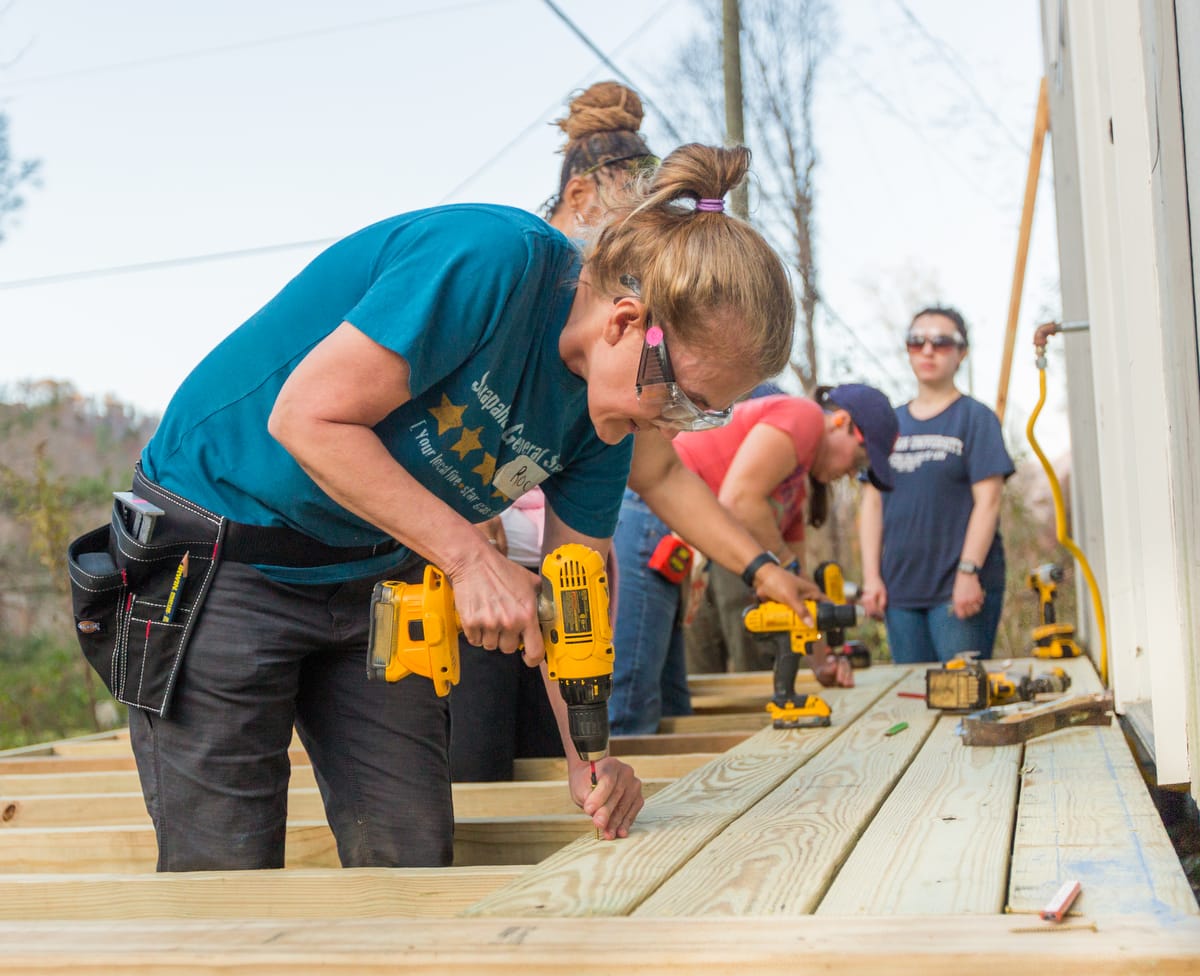
Day 3: Tools Finale, Plus Hands-on Basic Carpentry Practice
On day three, we’ll have our third and final tools class. We’ll cover:
- Levels
- Chalk lines
- Hammers
- Hand saws
Next, we’ll work in small groups on simple, real-world projects. Many students tell us that this is the most valuable part of class. Indeed, it’s a way to get tool use into your muscle memory. That way, when you go home you’ll have a feeling of familiarity with the tools; you’ll know them, rather than just know about them.
These projects vary, based on community disaster relief work and campus infrastructure needs at the time of class. However, they’re always something real; you won’t just be cutting and screwing scrap wood, you’ll be contributing to building something that will be used by the community.
These projects give students an opportunity to practice the basic carpentry skills that are the foundation of this class.
In 2025, most of our carpentry group projects will focus on directly contributing to community rebuilding following Hurricane Helene. Funds for these materials are provided by the Wild Abundance Disaster Relief Fund.
Some examples of group projects that we’ve worked on in the past:
- Siding or sheathing on a building
- Deck building
- Small bridge construction
- Picnic tables
- Children’s play structure
- Shelves
- Fences
During group project work in our carpentry classes for women, students will practice measuring, making cuts, using levels and speed squares, and fastening boards. Beyond the basic use of tools, we’ll also practice working together and getting our hands, minds, and bodies in the groove of doing serious carpentry.
These projects are invaluable for getting the basics of carpentry deep into your bones. It’s one thing to learn about tools, it’s something quite different to become proficient with them, and that’s just what students will do during these group projects.
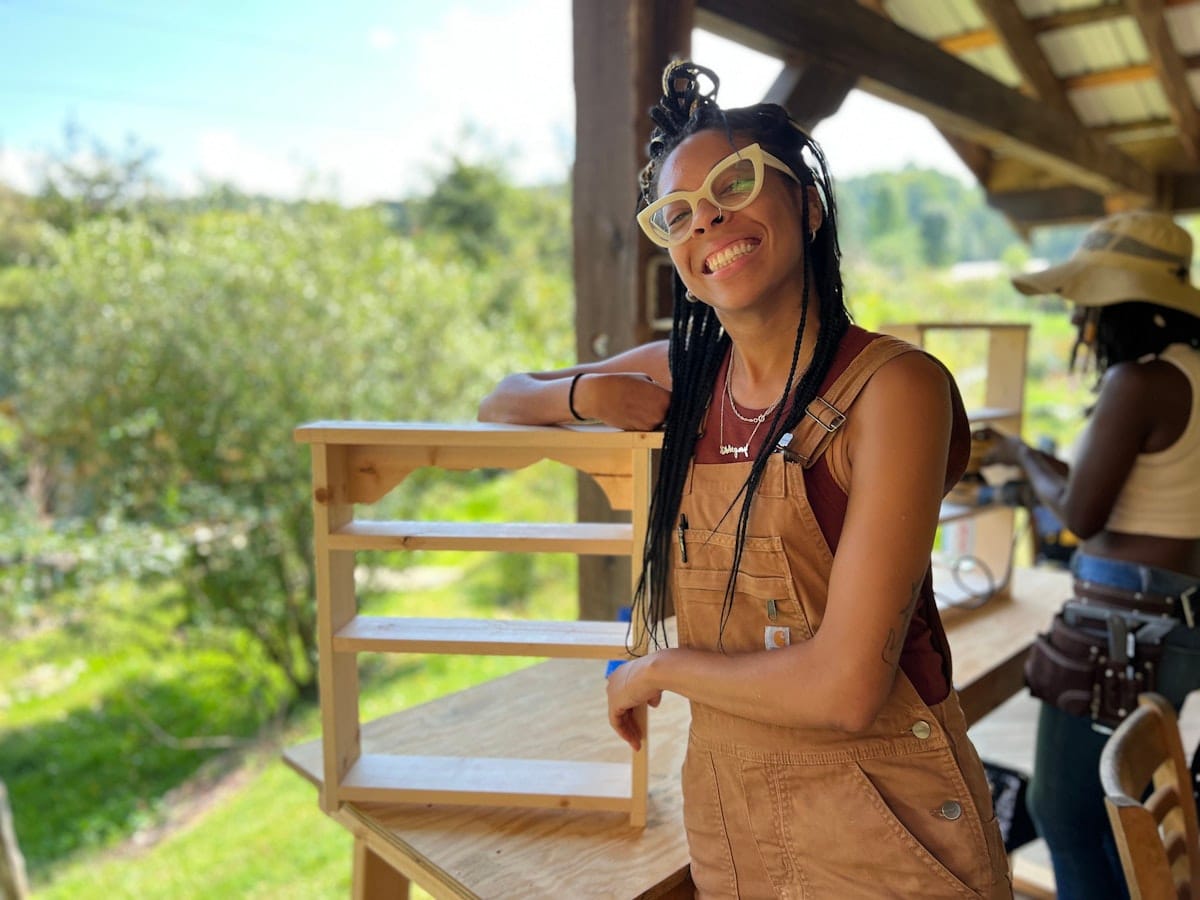
Day 4: Your Own Woodworking Project
Build your very own rough and simple masterpiece in this carpentry class for women
On day four, everyone will get to measure out, cut the pieces for, assemble, and complete (time permitting) a woodworking project of their very own—with lots of support, if they want it! To do this, we’ll reference the designs we solidified on day two and utilize the materials we purchased at the lumber yard. Throughout the process, instructors will circulate to answer questions, provide guidance, and avert disaster. Students will work semi-independently, making use of all the skills and confidence they’ve been building over the past three days. This day is the cherry on top for this woodworking class for women.
Ready to Join?
We’ll let you know when classes open for registration, and send you our fun and informative newsletters.
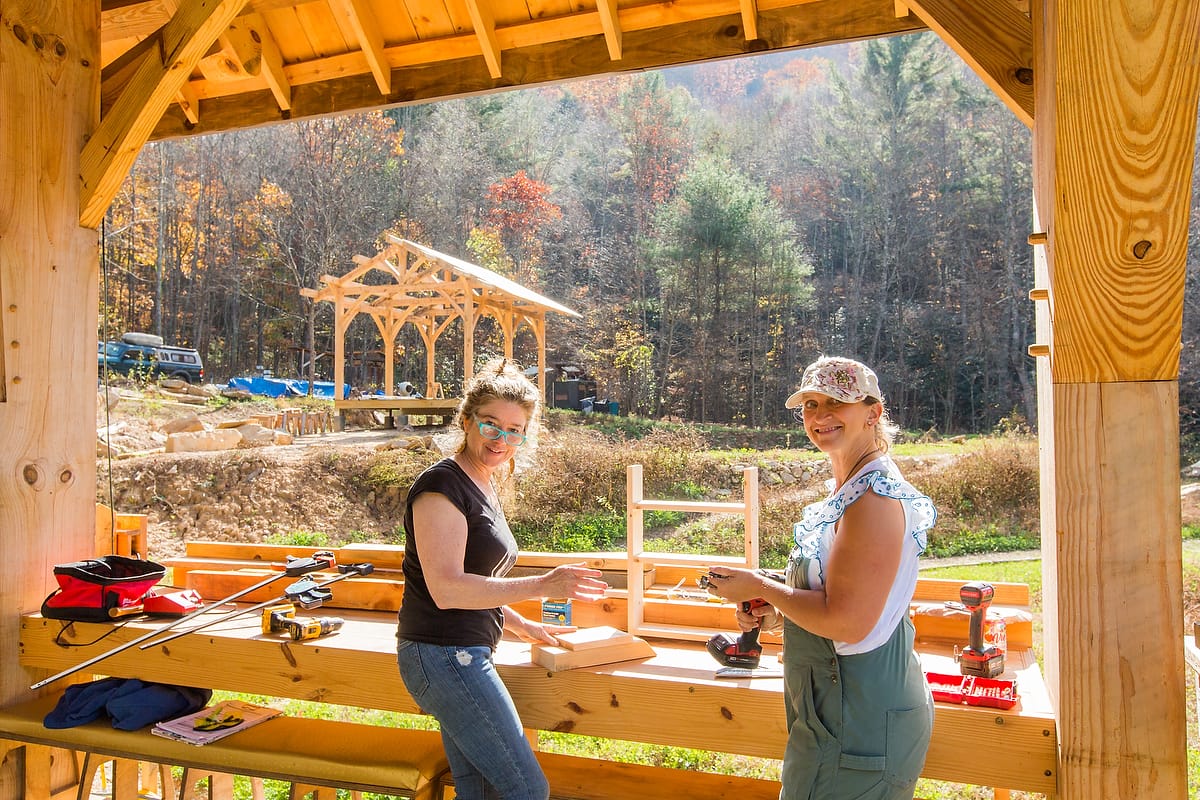
Enjoy our beautiful outdoor woodshop near Asheville, NC
The Women’s Basic Carpentry Classes are held at the outdoor “woodshop” located on the beautiful Wild Abundance Paint Fork Campus. During the class, we’ll work in several covered areas amidst gorgeous mountain views, native plants, and a bustling land-based living school.
There, students can use tools and work on projects with fresh air and direct connection to nature. Getting to learn and work in this simple, outdoor woodshop can be very inspiring; you don’t need a climate controlled $40,000 woodshop in order to use tools and build beautiful things! It’s the perfect setting for our women’s woodworking classes.
Please note: class happens mostly outdoors (under cover), rain or shine, whatever the temperature.
You’re just one women’s carpentry class away from building your ideas into reality.
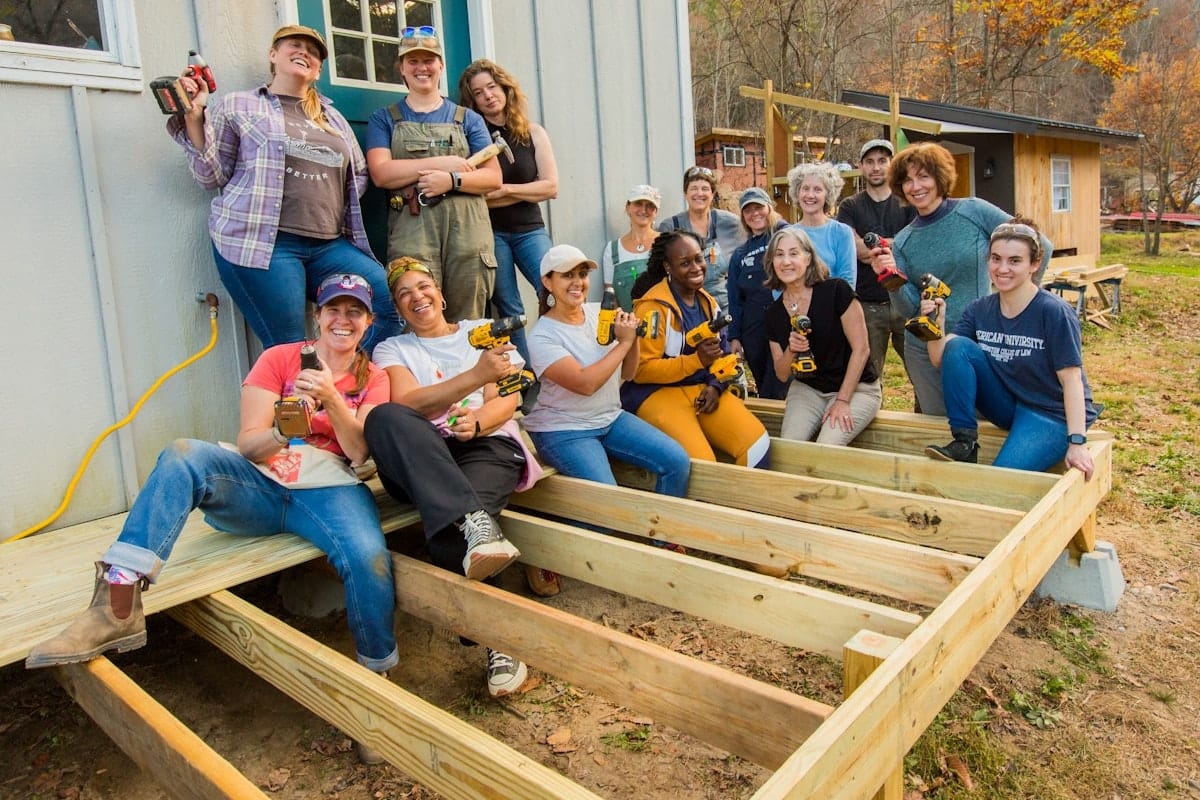
You might be asking yourself, can I really learn to use power tools and build things on my own in a weekend carpentry class? We’re here to tell you that, yes, it’s absolutely possible!
In one long weekend, you can get comfortable with tools, understand how to work with wood, and learn how to plan out and design your own simple woodworking and carpentry projects. We’ve seen it happen time and again, with thousands of satisfied students.
Over the past 12 years, we’ve offered our 4-day basic women’s beginner carpentry classes about 100 times, and with every session we receive and integrate feedback from our students and teachers. That means, over many years of care and commitment to serving students in the best way possible, we’ve been able to create a structure that is optimal for learning. We are continually blown away by the progress our students make in just four days!
Of course, people spend lifetimes perfecting their woodworking skills, especially those who build houses or do fine finish work like cabinetry or furniture making. It’s not realistic to learn how to do these high-level kinds of projects in a long-weekend workshop. However, you can take the first steps that every carpenter and fine woodworker once took. And you’ll leave with the ability to turn your ideas into reality, right away.
Ready to Join?
We’ll let you know when classes open for registration, and send you our fun and informative newsletters.
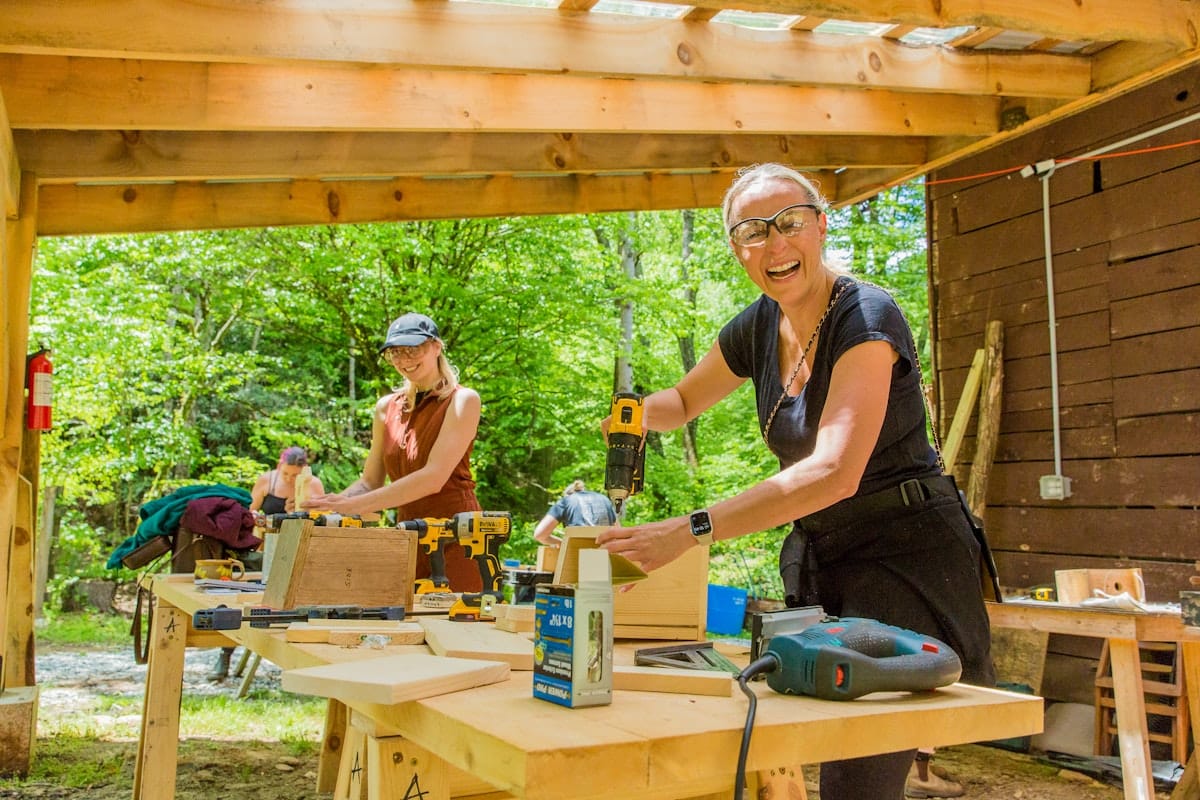
Frequently Asked Questions about Women’s Basic Carpentry
In this basic women’s carpentry class, you’ll learn how to properly and safely use the following tools:
- Hammer
- Circular saw
- Table saw
- Chop saw/miter saw
- Impact driver
- Drill
- Carpenter’s pencil
- Utility knife
- Measuring tape
- Speed square
- Chalk line
- Level
- Hand saw
- Cat’s paw
This is a basics class, but it also covers more advanced power tools, as well as the proper ways to measure and design projects. If you have some basic skills, but don’t feel totally confident in your technique or comfortable using bigger power tools, you’ll still get a lot out of this class. Consider combining the basic class with our Advanced Women’s Carpentry Class or Tiny House Workshop if you want to really strengthen your structural building skills. If you feel totally confident building small to medium projects on your own, with proper tool use, this class may be too basic for you.
We used to let women take our Advanced Women’s Carpentry Class without first taking the basic carpentry and woodworking class for women, if they thought they had enough experience. Time after time, we found that these women did not have the foundational safety and ergonomic tool-use skills that the graduates of the basics class did. As a result, our confidence in the power of the basics class has been fortified.
It’s clear that in four days so much more can be taught in this concentrated class than one might learn in years on their own. Because of this, we are now strict about only letting graduates of the Basics Class into the Advanced Class.
You’ll learn how to use most of the tools that are used in structural building, and some of the basic techniques, but this is not a structural building class. If you’re excited to build buildings, check out our Advanced Women’s Carpentry Course (you first need to take the Basic Carpentry Class) or our Tiny House Workshop. The advanced classes can be bundled with the basics class for a discount automatically applied at checkout.
We do have some male instructors because we just haven’t been able to find enough qualified female instructors. This is something that we are actively working to change. In fact, we have multiple female instructors who have attended our women’s basic, women’s advanced, and/or tiny house workshops, worked in the field for some years, and then have come back to teach.
When we need to fill in with male instructors, we choose them very carefully. Each one is incredibly patient, experienced and skilled at carpentry, and they are excellent teachers. We are intentional in choosing and training male instructors who aren’t just willing to teach women a basic carpentry class, but who also feel passionate about women’s empowerment and shifting imbalanced gender dynamics in carpentry. They tend to love teaching this class and feel honored to be invited into such a space.
We haven’t had complaints about our male instructors’ teaching or demeanor. On the contrary, we’ve had many, many compliments about their teaching styles, skills, knowledge, and ability to work gracefully with our students in these classes that are focused on carpentry for women.
Excellent question! Most carpentry in this country is done by men, and that is something Wild Abundance is in the interest of disrupting. Through our full array of building classes—the Women’s Basic Carpentry Classes, Beginner Carpentry Class for Adults, Advanced Women’s Carpentry Course (you first need to take the Basic Carpentry Class), Tiny House Workshop, and our 4 Month Carpentry Training Program—we center women’s bodies and women’s experiences. This is pretty rare in this country.
There are, however some other schools that do this, and occasionally one can find a female carpenter who takes on apprentices. Occasionally, you may even be able to find other women’s woodworking classes.
These opportunities are unfortunately few and far between, and we recommend delving deeply into the offerings here at Wild Abundance, where the instructors and staff truly care about expanding opportunities in carpentry for women.
Yes! All the tools and materials we ask you to get a hold of for this class will continue to be useful afterwards as you practice and hone your carpentry skills. This does not mean that you have to spend hundreds of dollars on the tools required to take the class. If you just get the bare bones, you could spend $30-$50. Or, you could choose to borrow tools from friends or family members. If you get all the required and optional tools, and choose the best brands, then you could be talking big bucks — and an awesome toolkit. Check out our list of both required and optional tools/supplies here.
Carpentry is the craft of using wood to build structures or work on buildings. Woodworking is generally a wood-based craft used to make furniture, cabinetry, and art. Carpentry typically happens onsite, and woodworking typically takes place in a shop. At the basic level, carpentry and woodworking are very similar. They both focus on cutting boards, fastening them together, and both use similar tools. Our basic carpentry class is relevant to both aspiring carpenters and woodworkers.
You will get a chance to design your own simple woodworking project during this class, with lots of support. This includes envisioning your project in space, choosing the thickness and type of wood that’s appropriate, choosing fasteners, making measurements, determining board-feet needed, etc. To ensure a smooth flow, and that everyone can finish their project, we offer 3 types of projects to choose from: a bookshelf, tool caddy, or birdhouse. You’ll have some creative license within these projects.
If you prefer to work with a done-for-you design, that’s an option, too. In that case, you could choose a project design that is identical to the example projects presented during class. Doing this means all the math will be done for you.
This class is only for women and non-binary folks, but we do offer a Beginner Carpentry Class for Adults that’s open to everyone. This is a great option for couples, siblings, or friends of different genders who want to learn together.
You’ll gain the skills to design and build custom furniture in this class, but it won’t be fancy. This is not a fine woodworking class that covers super-tight joinery or wood finishing. However, we do address project design, including how to look at an object and reverse engineer it into its pieces, so that you can copy things that you like the look of. We’ll also show you how to customize projects just for you.
This is one of a few classes in this country that is geared specifically toward women and non-binary folks. Plus, it’s probably the only one that takes place mostly outdoors in a beautiful mountain landscape. Add to this the fact that we’ve run close to 100 of these classes, and we’ve dialed in a flow and pace that really works. The intensive nature of our four-day carpentry classes for women means that you will get to learn a ton, practice it all, and go home really knowing how to do basic carpentry, not just understanding the basic concepts.
There may be a beginning woodworking class or basic carpentry classes closer to you, and it may or may not be geared toward women. Lots of community colleges offer beginning woodworking classes, and some are awesome. Others are either overly basic or too advanced for true beginners. We encourage you to check out what might be available locally, and consider what type of learning environment, pace, and general vibe most appeals to you.
Our carpentry classes for women are held in a beautiful outdoor setting, are intensive and effective, and feel more like a fun retreat than a college class. You’re also likely to learn more in four days than you might learn in a semester or two during a community college night class.
Our women’s carpentry classes are accessible to students of moderate physical strength and energy. Part of the purpose of a gender-specific carpentry class is to teach in a way that makes carpentry accessible to people with different degrees of strength and physical prowess. We’ve had students with a wide range of ages and physical abilities thrive in the class. Throughout the days, there are opportunities to drink water, eat snacks, and take breaks.
It is worth considering that our campuses are hilly and rustic, and not accessible to folks with certain disabilities. The ground is uneven and requires a certain amount of balance and care to navigate comfortably. You’ll be walking around a bit as you learn here. Read more about our campuses here.
We’ve had a wide range of students take our carpentry classes for women. The average age of our students has been around 45. That being said, our oldest student was 76 and our youngest student was a teenager. We usually get about 35% of students who are over 50, 40% between 35-50, and 25% under 35. The nature of this class is very inclusive and supportive, regardless of age or other differences that students might have.
Instructors
Madison Moore
Nadi Udros
Pete McKelvey
Alex Kilgore
Tyler Lavenburg
Alexandra Miller
Mana Vermeulen-McLeod
Erica Doud
Sparrow Smith
Anne Knoflicek
Lily Harlin
Our Basic Carpentry Classes for Women are held at the Wild Abundance Paint Fork Campus
Our Paint Fork campus is a bustling creekside landscape with gorgeous mountain views, a breathtaking timber-framed pavilion classroom, and spacious covered open-air wood shops for learning building and carpentry in all weather, plus other lovely features. The Paint Fork campus is 30 minutes north of Asheville.
Please note: our campuses are all unconventional, with rustic amenities and uneven ground. Read more about planning your trip and about our campuses. You’ll receive detailed directions on how to get here upon registration.
You’ve got several options of where to stay during your class. Some students camp, some locals commute, and others choose to rent accommodations with more creature comforts.
Onsite camping (with your own warm bedding and rainproof tent or hammock) is available for free to all students (including locals) during class. Some set-up-for-you tents are available with cots and cozy bedding for a flat fee.
Campers and all students have access to a lovely outdoor kitchen equipped with a stove and hot and cold water, plus pots and pans, knives and cutting boards, bowls, plates, and utensils, along with an outdoor shower with hot and cold running water and an outhouse. If you’d rather rent a hotel, house or cottage, there are many available. We’ll share a curated list of nearby options once you’ve registered.
So you can better plan your trip to come learn with us, here’s some info on accommodations we offer, or that we link to in the student handbook you’ll receive upon registration. Below it you’ll find info on transportation.
- Camping with your own gear: free
- Staying in a large tent with a cozy cot and bedding that we set up for you: $200 flat fee; you can stay there anytime from 5pm before the first day of your class, to 12pm the day after your class ends.
- Hyper-local off-campus single rentals: $40-$2000/night + fees
- Hyper-local off-campus couples rentals: $20-100/person/night + fees
- Hyper-local off-campus group rentals: $25-$86/person/night + fees
Wild Abundance students are given awesome discounts at a local hotel, and a hyper-local inn. More information given in the student handbook upon registration.
Getting a place or renting a car with a group of fellow students and carpooling are great ways to make connections and reduce costs! We share contact info for each class so you can get in touch and make plans together. Everyone has a chance to keep their info private if they choose.
You won’t need a car during your class. There’s a chance you may want to run an errand or go out to dinner with fellow students, and if this happens, it’s highly likely that another student with a car will be happy to give you a lift.
We’ve also got a list of folks who will do airport and grocery shuttle runs for $50-$80 each way. We share this information in the student handbook when you register. If you’d rather rent a car, those run anywhere from $45-$200/day. Just like with lodging, teaming up with a group of fellow students to share a car rental can help build connections and reduce costs.
Note: April 2025 Women’s Basic Carpentry classes will be held at the Sanford Way campus, which is 5 miles from the Paint Fork Campus due to construction.
Pricing for Women’s Basic Carpentry
Single Class: $850-$1700*
Package (Includes Basic and Advanced Women’s Carpentry): $1600-$3200*
*Please pay what you can within this range. The median price helps cover the class costs. Choose the low end if you’re low income, or the maximum fee if your household earns over $115,000/year. Place yourself within this range based on your income.
